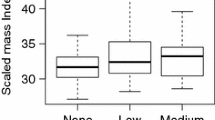Summary
The sequence of molt inCinnyricinclus leucogaster differs markedly from that in most passerine birds. Instead of having body molt proceed concurrently with that of wing and tail, the main body molt begins only after wing and tail molt are complete. Within the wing molt, the sequence of primary molt is normal descending, but that of secondary molt is peculiar. In most passerine bird, the three inner secondaries (nos. 7–9, the “tertials”) start the secondary molt followed by the six outer secondaries, but inCinnyricinclus the tertials do not begin molting until secondary 3 is growing. Secondaries 5 and 6, which are replaced in other Songbirds at the time of the last primary, are delayed until the time of body molt. This delayed molt of contour feathers and inner secondaries has the adaptive advantage of permitting the male to enter courtship activities with the maximum amount of violet gloss.
Migration may occur at any point in the molting cycle. Some populations do not migrate until after the complete molt, others leave after wing and tail molt is finished, and still others at various stages during wing molt. One population migrates immediately after breeding, and then returns in early winter to the breeding grounds and has the annual molt before, rather than after the nesting season.
Zusammenfassung
Der afrikanische StarCinnyricinclus leucogaster befolgt bei der Vollmauser eine andere Reihenfolge im Wechsel des Gefieders als die übrigen passerinen Vögel. Bei diesen erfolgt die Körpermauser während der Erneuerung von Flügel und Schwanz;Cinnyricinclus dagegen wartet mit der Körpermauser, bis Flügel und Schwanz fertig sind. Die Mauser der Handschwingen geschieht in descendenter Folge, also so wie bei anderen Singvögeln; die Armschwingen dagegen werden auf eigenartige Weise gewechselt. Während bei den meisten übrigen Singvögeln zwei oder gar alle drei Schirmfedern (A 8, 9, 7) den Anfang machen, fällt die erste von ihnen beiCinnyricinclus erst dann aus, wenn A 3 wächst. A 5 und A 6, die bei anderen Singvögeln vor oder zugleich mit H 9 zu verhornen pflegen, werden erst dann erneuert, wenn die Körpermauser heftig einsetzt.
Die verzögerte Mauser der Körperfedern und inneren Armschwingen hat zur Folge, daß das Männchen in größtmöglicher Pracht seines violett schillernden Gefieders um das Weibchen wirbt.
Die nach der Brutzeit einsetzende Wanderung kann in einem beliebigen Stadium des Mauserzyklus unternommen werden. Einige Populationen warten damit bis nach dem Ende der Vollmauser, andere brechen auf, wenn Flügel und Schwanz erneuert sind, und wieder andere während verschiedener Stadien der Flügelmauser. Eine Population verläßt das Brutgebiet gleich nach Beendigung des Brutcyclus, erscheint dann aber dort schon zu Beginn des „Winters“ wieder und erneuert das ganze Gefieder nicht nach, sondern vor der Periode der Fortpflanzung.
Similar content being viewed by others
Literature
Benson, C. W. (1953): A check list of the birds of Nyasaland. — Blantyre.
Benson, C. W., R. K. Brooke andC. J. Vernon (1964): Bird breeding data for the Rhodesias and Nyasaland. — Occ. Pap. Nat. Mus. So. Rhodesia 27 B, p. 30–105.
Chapin, J. P. (1954): The birds of the Belgian Congo, part 4. — Bull. Amer. Mus. Nat. Hist 75 B.
Clancey, P. A. (1964): The birds of Natal and Zululand. — London.
Jackson, F. J. andW. L. Sclater (1938): The birds of Kenya Colony and the Uganda Protectorate, vol. III. — London.
Jackson, S. P. (1961): Climatological Atlas of Africa. — Pretoria.
Keay, R. W. J. (1959): Vegetation Map of Africa. — London.
Lawson, W. J. (1965): Notes on some Swaziland birds. — Ostrich 36, p. 96.
Michener, H. and —— (1940): The molt of House Finches of the Pasadena region, California. — Condor 42, p. 140–153.
Miller, A. H. (1928): The molts of the Loggerhead Shrike,Lanius ludovicianus L. — Univ. California Publ. Zool. 30, p. 393–417.
—— (1961): Molt cycles in Equatorial Andean sparrows. — Condor 63, p. 143–161.
Pitelka, F. A. (1945): Pterylography, molt and age determination of American jays of the genusAphelocoma. — Condor, 47, p. 229–260.
—— (1958): Timing of molt in Steller Jays of the Queen Charlotte Islands, British Columbia. — Condor 60, p. 38–49.
Schouteden, H. (1956): De vogels van Belgisch Congo en van Ruanda-Urundi, pt. VIII. — Ann. Mus. Roy. Congo Belge, Zool., Ser IV, vol. 5., fasc. 1.
-- (1964): La faune ornithologique de la Province du Kasai. — Docum. Zool. Tervuren, no. 6.
-- (1965): La faune ornithologique des Territoires de Dilolo et Kolwezi de la Province du Katanga. — Docum. Zool. Tervuren, no. 9.
Someren, V. D. van (1958): A bird watcher in Kenya. London.
Stresemann, E. and V. (1966): Die Mauser der Vögel. — J. Orn. 107, Sonderheft.
—— (1968): Die Mauser vonAnthus campestris undAnthus richardi. — J. Orn. 109, p. 17–21.
Traylor, M. A. (1965): A collection of birds from Barotseland and Bechuanaland. — Ibis 107, p. 137–172, 357–384.
—— (1967): A collection of birds from Szechwan. — Fieldiana: Zool. 53, p. 1–67.
West, O., F. B. Wright andG. Symons (1964): The birds of Weenen County, Natal. — So. Afr. Avifauna Ser. no. 14.
White, C. M. N. (1962): A revised check list of African Shrikes, Orioles, etc. Lusaka.
Winterbottom, J. M. (1942): A contribution to the ornithology of Barotseland. — Ibid 1942, p. 337–389.
—— (1959): Notes on the status of some birds in Northern Rhodesia. — Ostrich 30, p. 1–12.
-- (1966): Results of the Percy FitzPatrick Institute-Windhoek State Museum Joint Ornithological Expeditions: 3. Report on the birds of the Okavango Valley. — Cimbebasia 15.
Author information
Authors and Affiliations
Rights and permissions
About this article
Cite this article
Traylor, M.A. Molt and migration inCinnyricinclus leucogaster . J Ornithol 112, 1–20 (1971). https://doi.org/10.1007/BF01644076
Published:
Issue Date:
DOI: https://doi.org/10.1007/BF01644076




